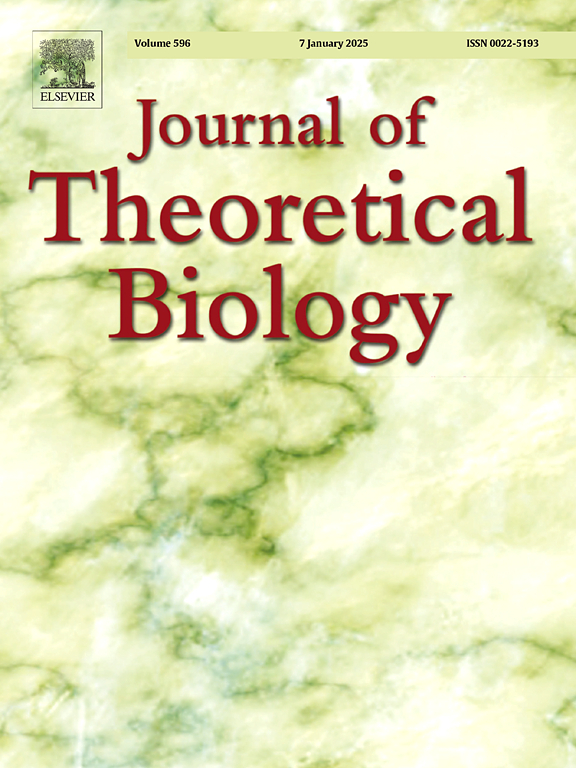How population control of pests is modulated by density dependence: The perspective of genetic biocontrol
IF 2
4区 数学
Q2 BIOLOGY
引用次数: 0
Abstract
Managing pest species relies critically on mechanisms that regulate population dynamics, particularly those factors that change with population size. These density-dependent factors can help or hinder control efforts and are especially relevant considering recent advances in genetic techniques that allow for precise manipulation of the timing and sex-specificity of population suppression. Despite this importance, density dependence is often poorly characterized owing to limited data and an incomplete understanding of organism development. To address this issue, we construct and analyze a mathematical model of a pest population with a general control under a wide range of density dependence scenarios. Using this model, we investigate how control performance is affected by the strength of density dependence. By modifying the timing and sex-specificity of the control, we tailor our analysis to simulate different pest control strategies, including conventional and genetic biocontrol methods. We pay particular attention to the latter, using case studies to explore specific examples with an extended version of the baseline model that includes genetic dynamics. Finally, we clarify past work on mechanistic models with flawed derivations that do not exhibit overcompensatory density dependence. We find substantial differences in control performance for differing strengths of density dependence, with populations exhibiting strong density dependence being most resilient to suppression. However, these results change with the size and timing of the control load, as well as the target sex. Interestingly, we also find that the strength of density dependence affects population invasion by certain genetic biocontrol strategies. While the model is parameterized using the life history traits of the yellow fever mosquito, Aedes aegypti, the principles developed here apply to many pest species. We conclude by discussing the implications of density dependence timing and strength for suppression of pest populations.
害虫的种群控制是如何由密度依赖调节的:遗传生物防治的观点。
有害生物的管理主要依赖于调节种群动态的机制,特别是那些随着种群规模而变化的因素。这些依赖于密度的因素可以帮助或阻碍控制努力,特别是考虑到遗传技术的最新进展,可以精确操纵种群抑制的时间和性别特异性。尽管具有这种重要性,但由于数据有限和对发育生态学的不完全了解,对密度依赖性的描述往往很差。为了解决这一问题,我们构建并分析了在广泛的密度依赖情景下具有一般控制的害虫种群的数学模型。利用该模型,我们研究了密度依赖强度对控制性能的影响。通过调整控制的时间和性别特异性,我们调整了我们的分析,以模拟不同的害虫控制策略,包括传统和遗传生物控制方法。我们特别关注后者作为案例研究,通过扩展基线模型包括遗传动力学。最后,我们澄清了过去在密度依赖机制模型动力学方面的工作。我们发现不同密度依赖性强度的控制效果存在实质性差异,表现出强烈密度依赖性的种群对抑制的适应性最强。然而,这些结果随着控制负荷的大小和时间以及目标性别而变化。有趣的是,我们还发现密度依赖的强度通过某些遗传生物控制策略影响种群入侵。虽然该模型是使用黄热病蚊子埃及伊蚊(Aedes aegypti)的生活史特征参数化的,但这里开发的原则适用于许多害虫物种。最后,我们讨论了这对害虫种群抑制的意义。
本文章由计算机程序翻译,如有差异,请以英文原文为准。
求助全文
约1分钟内获得全文
求助全文
来源期刊
CiteScore
4.20
自引率
5.00%
发文量
218
审稿时长
51 days
期刊介绍:
The Journal of Theoretical Biology is the leading forum for theoretical perspectives that give insight into biological processes. It covers a very wide range of topics and is of interest to biologists in many areas of research, including:
• Brain and Neuroscience
• Cancer Growth and Treatment
• Cell Biology
• Developmental Biology
• Ecology
• Evolution
• Immunology,
• Infectious and non-infectious Diseases,
• Mathematical, Computational, Biophysical and Statistical Modeling
• Microbiology, Molecular Biology, and Biochemistry
• Networks and Complex Systems
• Physiology
• Pharmacodynamics
• Animal Behavior and Game Theory
Acceptable papers are those that bear significant importance on the biology per se being presented, and not on the mathematical analysis. Papers that include some data or experimental material bearing on theory will be considered, including those that contain comparative study, statistical data analysis, mathematical proof, computer simulations, experiments, field observations, or even philosophical arguments, which are all methods to support or reject theoretical ideas. However, there should be a concerted effort to make papers intelligible to biologists in the chosen field.

 求助内容:
求助内容: 应助结果提醒方式:
应助结果提醒方式:


